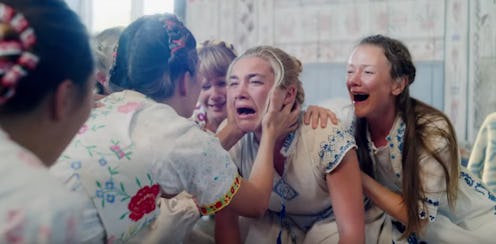Entertainment
Here’s The Deal Behind That Creepy ‘Midsommar’ Village, So You Can Stay Far, Far Away
Coming to theaters on July 3, Midsommar follows a group of graduate students to a small commune in Sweden that's celebrating a once-in-a-lifetime festival. Dani (Florence Pugh), Christian (Jack Reynor), and their other American friends are invited by Pelle (Vilhelm Blomgren), who grew up there. They could never have prepared themselves for the horrible rituals that the festival actually entails, and not everything in the film is totally fictionalized. Will the Midsommar version of the village of Hårga was totally created for the film, there is a real village in Sweden that also carries that name.
In real life, Hårga is thankfully not the rural site of the fictional community in the film. (The Midsommar villagers themselves are also called the Hårga — it's confusing.) The real place is located near the west coast of Sweden, north of Stockholm. If you visit it for the real Midsummer holiday, which celebrates the summer solstice, you won't encounter the various horrors that Dani and Christian do. Midsummer celebrations usually include flower gathering and weaving along with a dancing game called Små grodorna, according to Real Scandinavia.
The movie's Hårga, however, is home to a group living outside of many cultural norms that the Americans hold dear. The village itself was built for the film. “I felt it was important for audiences to be able to see different parts of the village in every shot, as though you were actually there celebrating with the Hårga,” filmmaker Ari Aster says in the production notes. “I wanted the geography of the village to be something the audience comes to know in their bones by the end of the movie.” The notes go on to say that Aster and production designer Henrik Svensson had the entire village mapped out before they even chose a location for it to be built. (The fake Hårga was actually constructed outside of Budapest, not in Sweden.)
Aster told Rotten Tomatoes that the rituals and events depicted in Midsommar don't just come from a single, cultural source. "It’s drawn from a lot of research, there’s a lot of actual tradition that’s sort of buried in the film, there’s a lot of folklore," he said. "I was pulling from a lot of different spiritual movements that have nothing to do in many cases with even Sweden, but there are hundreds of things kind of woven together here."
Although he hasn't mentioned this specifically, it's possible that a real Swedish legend about Hårga led Aster to name his town after it. There's a traditional Swedish folk song called "Hårgalåten," or "The Hårga Song." The song tells the story of how the devil disguised himself as a fiddler and made the young people of the village dance until they dropped dead.
"Stop your bow, fiddler," the translated lyrics read, "before we dance our life, soul and bones away."
Even with all the references packed into it, Midsommar is pure fiction and not a reflection of any real religious group or settlement. Still, if you ever find yourself in the north of Sweden, a certain town name may give you the shivers.
